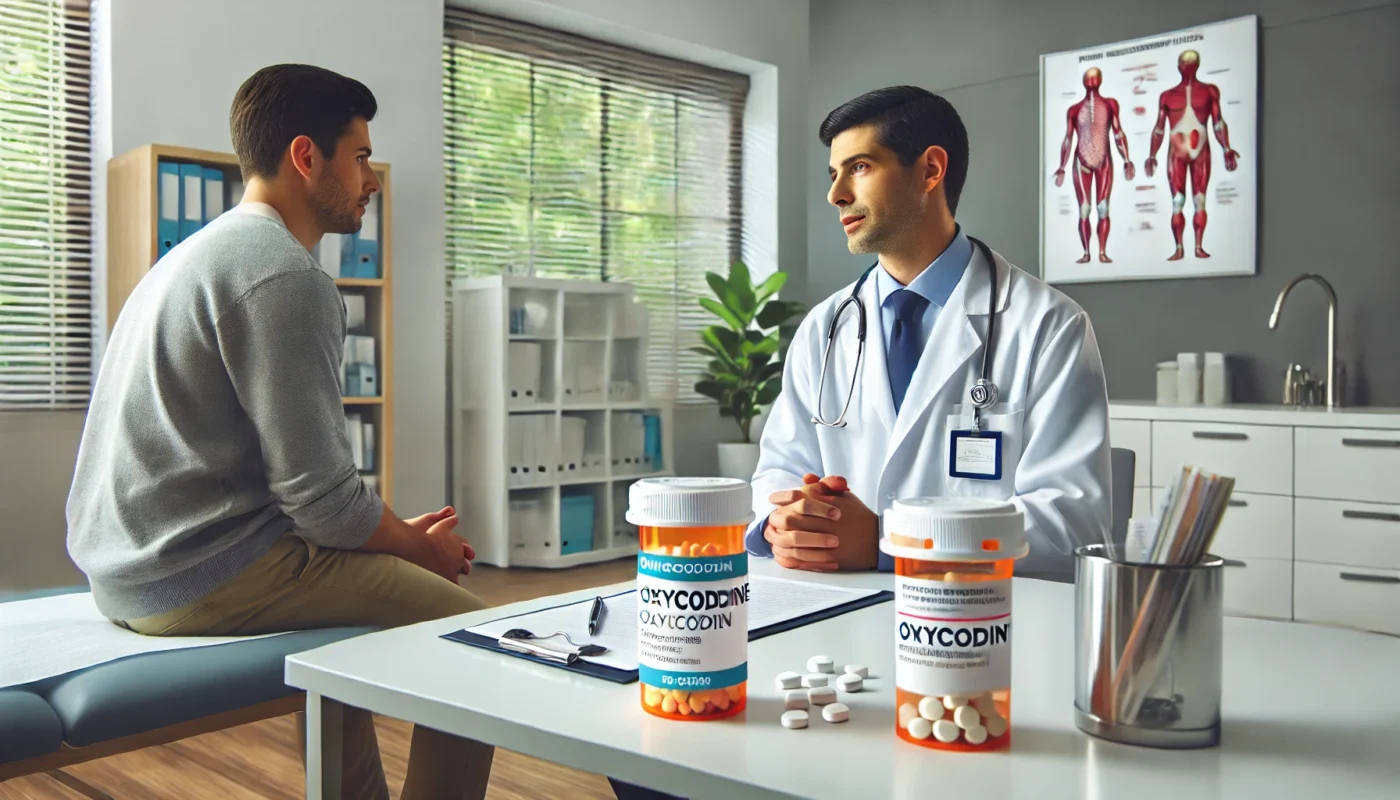Oxycodone and Vicodin are both opioid medications, but they differ in their composition and application.
You may also like: Understanding Long-Term Pain Relief Options
Composition and Origins
Oxycodone is a potent opioid analgesic derived from thebaine, an alkaloid found in the Persian poppy. It is often prescribed under brand names like OxyContin and Percocet, the latter of which combines oxycodone with acetaminophen. This combination enhances pain relief while aiming to limit the amount of opioid required for effective treatment.
Vicodin, on the other hand, is a combination of hydrocodone and acetaminophen. Hydrocodone is another opioid pain reliever similar to oxycodone but is often considered slightly less potent on a per-milligram basis. The addition of acetaminophen in both Vicodin and Percocet can increase the risk of liver damage if taken in high doses or over extended periods.
Applications in Pain Management
Both medications are used to treat pain, but they can vary in effectiveness and side effects depending on individual responses and the specific nature of the pain being treated. Oxycodone is often reserved for more intense pain scenarios due to its higher potency. It is frequently prescribed following surgeries or for cancer-related pain.
In contrast, Vicodin is commonly used for less severe pain types, such as injury-related pain or dental procedures. The choice between the two can depend heavily on the patient’s medical history and their experience with past pain medications.

Side Effects and Considerations
Opioids like oxycodone and Vicodin can cause side effects such as drowsiness, nausea, constipation, and dizziness. Long-term use can lead to tolerance, dependence, and potentially addiction. It’s crucial for patients and healthcare providers to weigh the benefits of pain relief against these risks, considering non-opioid alternatives when possible.
Can You Take Hydrocodone with Oxycodone?
A common question that arises in the context of pain management is whether it’s safe to take hydrocodone (found in Vicodin) with oxycodone.
Risks of Combining Opioids
Generally, combining these two opioids is not recommended due to the increased risk of severe side effects, including respiratory depression, sedation, and potential for overdose. Both drugs act on the central nervous system to provide pain relief, but they also depress the respiratory system. When combined, these effects can be dangerously amplified.
The Role of a Healthcare Provider
Therefore, it’s crucial to follow a healthcare provider’s guidance and not mix these medications unless specifically directed. Healthcare providers assess the risk-benefit ratio before prescribing any combination of opioids. They might suggest rotating between the two rather than simultaneous use to avoid cumulative effects.
Monitoring and Adjustments
Patients should be vigilant about monitoring their body’s response to these medications. Any signs of excessive sedation, difficulty breathing, or unusual side effects should be immediately reported to a healthcare professional. Continuous communication can help adjust dosages or explore alternative pain management options.
Vicodin and Percocet: What’s the Difference?
While both Vicodin and Percocet are used for pain relief, their differences lie in their composition and strength.
Composition Differences
As mentioned, Vicodin contains hydrocodone and acetaminophen, whereas Percocet combines oxycodone with acetaminophen. The active opioid ingredient sets the two apart in terms of potency and potential side effects.
Potency and Prescription Context
Percocet is often considered more potent due to the presence of oxycodone, which is generally stronger than hydrocodone. This means that Percocet might be prescribed for more severe pain or for patients who do not respond well to hydrocodone-containing medications like Vicodin. The choice between these two medications can also depend on the duration of pain relief needed.
Side Effects and Patient Tolerance
Each medication’s side effect profile can influence which is chosen for pain management. While both can cause similar side effects, individual patient tolerance can vary significantly. Some patients might experience fewer side effects with one medication over the other, influencing their doctor’s prescription choice.
Is Percocet Hydrocodone?
A common misconception is that Percocet contains hydrocodone.
Clarifying Misunderstandings
However, Percocet actually contains oxycodone, not hydrocodone. This distinction is important because oxycodone and hydrocodone, while similar in their opioid classification, have different potencies and side effect profiles.
Importance of Ingredient Knowledge
Understanding the active ingredients in your medication is crucial for safe usage and for communicating effectively with healthcare providers about your pain management needs. Misunderstanding medication contents can lead to incorrect assumptions about dosage and effects.
Communication with Healthcare Providers
Patients should always clarify any doubts about their prescriptions with their healthcare provider. This ensures that they are informed about what they are taking and understand the potential effects, both intended and side.
Oxycodone vs. Vicodin: Choosing the Right Medication
Choosing between oxycodone and Vicodin depends on several factors, including the severity of pain, previous responses to pain medications, and individual health considerations. Here are a few points to consider:
Pain Severity and Response
For more severe pain or if you’ve had a limited response to hydrocodone in the past, your doctor might recommend oxycodone. Conversely, for moderate pain, Vicodin might be sufficient. This decision is based on clinical guidelines and the physician’s judgment, taking into account your pain history and current condition.

Side Effect Profile
Both medications can cause side effects such as drowsiness, constipation, nausea, and dizziness. However, some individuals may tolerate one medication better than the other. It’s important to communicate with your healthcare provider about any adverse effects you experience. This feedback can help in tailoring your treatment plan to minimize discomfort.
Risk of Dependence and Addiction
Opioids carry a risk of dependence and misuse. If there is a history of substance use disorder, this risk must be carefully managed, possibly necessitating alternative pain management strategies. Physicians might employ tools like opioid contracts or regular urine screenings to monitor use.
Personal Health Considerations
Factors such as liver function, history of gastrointestinal issues, and other medications being taken can affect which opioid is safer for you. Your healthcare provider will consider these aspects to ensure that your pain management plan is both effective and safe.

Practical Tips for Managing Opioid Use
Using opioids safely requires diligence and awareness. Here are some practical tips:
Follow Prescriptions Closely
Always adhere to the prescribed dosage and timing. Do not adjust your dose without consulting your healthcare provider. Missing doses or taking extra doses can lead to complications or ineffective pain management.
Avoid Alcohol and Other Sedatives
Combining opioids with alcohol or other sedatives can increase the risk of dangerous side effects. This combination can severely depress the respiratory system, leading to life-threatening conditions.
Monitor Side Effects Diligently
Keep track of any side effects and report them to your healthcare provider. This can help in adjusting your treatment plan effectively. Maintaining a journal of your medication intake and side effects can be a valuable tool for your doctor.
Explore Alternative Pain Management
Consider integrating alternative therapies such as acupuncture, physiotherapy, or mindfulness practices to complement medication use. These approaches can help reduce reliance on opioids and improve overall pain management.
Safety and Storage
Store medications securely to prevent misuse or accidental ingestion by others, especially children. Dispose of unused opioids properly through take-back programs or other recommended disposal methods.
Conclusion
Understanding oxycodone and Vicodin, along with their uses and risks, is key to effective and safe pain management. Always communicate openly with your healthcare provider about your pain levels, medication effects, and any concerns you might have. By doing so, you can ensure that your approach to pain management is both safe and effective, allowing you to maintain the highest possible quality of life.
Remember, the goal is not just to manage pain, but to do so in a way that supports overall health and wellbeing. With the right knowledge and strategies, you can navigate the complexities of opioid use and optimize your recovery journey. Staying informed and proactive in your pain management plan can significantly contribute to your overall treatment success and quality of life.
Further Reading:
Oxycodone vs. hydrocodone: The differences and risks you need to know about
Hydrocodone/oxycodone overdose
Use of Codeine, Oxycodone, and Other Opioids: Information for Employees
Oxycodone, Vicodin, opioid medications, pain management, hydrocodone, acetaminophen, side effects, addiction, prescription drugs, pain relief, healthcare provider, opioid safety, medication awareness, alternative therapies, patient education
Important Note: The information contained in this article is for general informational purposes only, and should not be construed as health or medical advice, nor is it intended to diagnose, prevent, treat, or cure any disease or health condition. Before embarking on any diet, fitness regimen, or program of nutritional supplementation, it is advisable to consult your healthcare professional in order to determine its safety and probable efficacy in terms of your individual state of health.Regarding Nutritional Supplements Or Other Non-Prescription Health Products: If any nutritional supplements or other non-prescription health products are mentioned in the foregoing article, any claims or statements made about them have not been evaluated by the U.S. Food and Drug Administration, and such nutritional supplements or other health products are not intended to diagnose, treat, cure, or prevent any disease.

